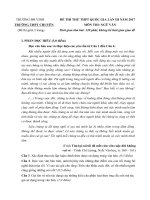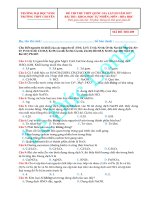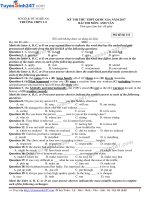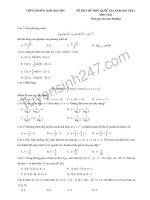- Trang chủ >>
- THPT Quốc Gia >>
- Ngoại Ngữ
Đề thi thử THPT Quốc gia môn Anh năm 2017 (có đáp án) Sở GDDT Nghệ An
Bạn đang xem bản rút gọn của tài liệu. Xem và tải ngay bản đầy đủ của tài liệu tại đây (569.11 KB, 5 trang )
SỞ GD & ĐT NGHỆ AN
TRƯỜNG THPT 1-5
KỲ THI THỬ THPT QUỐC GIA NĂM 2017
BÀI THI MÔN: ANH VĂN
Thời gian làm bài: 60 phút
Mã đề thi 111
(Thí sinh không được sử dụng tài liệu)
Họ, tên thí sinh:..................................................................... SBD: .............................
Mark the letter A, B, C, or D on your answer sheet to indicate the word that has the underlined part
pronounced differently from the rest in each of the following questions.
Question 1. A. reserved
B. locked
C. forced
D. touched
Question 2. A. arrange
B. arise
C. area
D. arrive
Mark the letter A, B, C, or D on your answer sheet to indicate the word that differs from the rest in the
position of the main stress in each of the following questions.
Question 3. A. apply
B. visit
C. appear
D. attend
Question 4. A. curriculum
B. kindergarten
C. contaminate
D.conventional
Mark the letter A, B, C, or D on your answer sheet to show the underlined part that needs correction in
each of the following questions.
Question 5. He (A) comes from a (B) large family, all of (C) them now (D) live in Australia.
Question 6.(A)What happened in that city (B) were a reaction from city workers,(C) including firemen
and policemen who had been laid off from (D) their jobs.
Question 7. (A) Globally and internationally, the 1990’s stood (B) out as the (C) warmest decade in the
history of (D) weather records.
Mark the letter A, B, C, or D on your answer sheet to indicate the correct answer to each of the following
questions.
Question 8. I'll give you my answer if I_____ you this Sunday afternoon.
A. see
B. saw
C. will see
D. am seeing
Question 9. He managed to climb over the wall without ______ .
A. seeing
B. being seen
C. to see
D. to be seen.
Question 10. Do you know the person ______ next to you in the evening class?
A. who sit
B. whom sits
C. sitting
D. whose sitting
Question 11. Tony Blair is believed _____ for Liverpool last week.
A. leaving
B. to leave
C. having left
D. to have left
Question 12. It was not until recently………………….how truthful he was.
A. which we realized B. when we realized
C. did we realize D. that we realized
Question 13: Tom has just had a computer ______ in his room.
A. install
B. installed
C. to install
D. is installing
Question 14: The choir stood in four rows according to their ________ heights.
A. respected
B. respective
C. respectable
D. respectful
Question 15: If the doctor had arrived sooner, the boy .................................................
A. might be saved
B. have been saved
C. was saved
D. might have been saved
Question 16: Doing a lot of homework may ___________you to pass the exam.
A. make it easier for
B. make easier for
C. be easy for
D. make easy that
Question 17: It was very difficult to ___ what he was saying about the noise of the traffic.
A. pick up
B. make up
C. turn out
D. make out
Question 18: Her husband treated her badly. I'm surprised she _________ it for so long.
A. put up with
B. put off
C. put through
D. put up
Question 19: It always pays to buy high-quality goods. In the long ____ it is cheaper.
A. race
B. rush
C. run
D. way
Mark the letter A, B, C, or D on your answer sheet to indicate the most suitable response to complete
each of the following exchanges.
>> Truy cập để học Toán – Lý – Hóa – Sinh – Văn – Anh - Sử - Địa tốt nhất!
1
Question 20: Julie and Nina are playing in the garden.
Julie: "Look at this beautiful butterfly!" - Nina: "_________________”
A. Where? I don't see it.
B. Yes, please.
C. Don't worry.
D. No, it's your turn
Question 21: Sarah's giving John a gift on his birthday.
John: "Thank you very much for the lovely gift."- Sarah:”_________________"
A. You're welcome.
B. Congratulations.
C. I'm not interested. D. No, I don't think so
Mark the letter A, B, C, or D on your answer sheet to indicate the word(s) or phrase(s) SIMILAR in
meaning to the underlined word(s) in each of the following questions.
Question 22. When being interviewed, you should concentrate on what the interviewer is saying or asking
you.
A. pay all attention to
B. express interest to
C. be related to
D. be interested in
Question 23. These anniversaries mark the milestones of a happy and lasting relationship between married
couples.
A. signs
B. achievements
C. landmarks
D. progresses
Mark the letter A, B, C, or D on your answer sheet to indicate the word(s) or phrase(s) OPPOSITE in
meaning to the underlined word(s) in each of the following questions.
Question 24: The earth is being threatened and the future looks bad.
A. done
B. made
C. defended
D. varied
Question 25: I clearly remember talking to him in a chance meeting last summer.
A. unplanned
B. deliberate
C. accidental
D. unintention
Mark the letter A, B, C, or D on your answer sheet to indicate the sentence that is closest in meaning to
each of the following questions.
Question 26: The challenges facing the new committee leader are numerous.
A. There are numerous challenges facing the new committee leader.
B. The new committee leader was ready to take numerous challenges.
C. To succeed, the new committee leader had to face numerous challenges.
D. Numerous challenges are going to face with the new committee leader.
Question 27: It is not until a Vietnamese girl getting 18 years old that she is allowed to get married legally.
A. A Vietnamese girl is not allowed to get married legally only when she gets18 years old.
B. They never allow a Vietnamese girl to get married legally when she is 18 years old.
C. The legal allowance for a Vietnamese girl to get married will be issued in 18 years.
D. A Vietnamese girl is allowed to get married legally only when she gets 18 years old.
Question 28: “Don’t leave the house until I get back, Jack” said his sister.
A. Jack’sister told him not to leave the house when she got back.
B. Jack’s sister told him to stay at home till she got back.
C. Jack’s sister told him to stay at home when she got back.
D. Jack’s sister told him not to go out until she gets back.
Mark the letter A, B, C, or D on your answer sheet to indicate the sentence that best combines each pair
of sentences in the following questions.
Question 29: The driver in front stopped so suddenly.Therefore , the accident happened.
A. If the driver in front didn’t stop so suddenly , the accident wouldn’t happen.
B. If the driver in front hadn’t stopped so suddenly, the accident wouldn’t have happened.
C. If the driver in front hadn’t stopped so suddenly, the accident would have happened.
D. If the driver in front had stopped so suddenly, the accident would have happened.
Question 30: A drug may affect several functions, even though it’s targeted at only one.
A. Despite various other uses, a drug usually has a function for a special effect.
B. A drug is taken for a specific purpose, but it may have a range of other effects.
C. The functions expected of a drug are various even if it is used for a specific disease.
D. However effective a drug may be, its functions have to be several.
Read the following passage and circle the letter A, B, C, or D to indicate the correct word or phrase that best
fits each of the numbered blanks from 31 to 35.
For most of us, going to school is (31) _____ everyday activity. There are probably days when you
don’t feel like going to school. You may even have come up with excuses not to go. Yet millions of children
>> Truy cập để học Toán – Lý – Hóa – Sinh – Văn – Anh - Sử - Địa tốt nhất!
2
dream of (32) _____ to school and don’t get the chance. Over 113 million children of primary school age
remain out of school and 60% of them are girls. There are 900 million young adults worldwide, and the
majority of them are women.
Some children miss out on school because the only schools available to (33) _____ charge fees to
attend and do not actually provide a decent education. They may charge fees that are (34)_____ than a poor
family’s monthly salary, or they may be of such poor quality (35)_____ children do not even learn how to
read or write. Schools may also be several hours walk away, or children may be needed at home to help with
household chores.
Question 31: A. a
B. an
C. one
D. any
Question 32: A. going
B. go
C. coming
D. come
Question 33: A. they
B. their
C. this
D. them
Question 34: A. highest
B. higher
C. lowest
D. lower
Question 35: A. which
B. that
C. when
D. where
Read the following passage and circle the letter A, B, C, or D to indicate the correct answer to each of the
questions from 36 to 42.
There is very little documentation about the origins of water polo. It is known, however, that the sport
originated in the rivers and lakes of mid-19th century England as an aquatic version of rugby. Early games
used an inflated rubber ball that came from India known as a "pulu" (the single Indian word for all "balls").
Pronounced "polo" by the English, both the game and the ball became known as "water polo." To attract
more spectators to swimming exhibitions, the London Swimming Association designed a set of water polo
rules for indoor swimming pools in 1870. At first, players scored by planting the ball on the end of the pool
with both hands. A favorite trick of the players was to place the five-to-nine inch rubber ball inside their
swimming suit and dive under the murky water, they would then appear again as close to the goal as
possible. The introduction of the rules by Scottish players changed the nature of water polo. It became a
game that emphasized swimming, speed and passing. Scottish rules moved from a rugby variant to a soccer
style of play. Goals became a cage of 10x 3 feet and a goal could be scored by being thrown. Players could
only be tackled when they "held" the ball and the ball could no longer be taken under water. The small
rubber ball was replaced by a leather soccer ball. If the player came up too near the goal, he was promptly
jumped on by the goalie, who was permitted to stand on the pool deck. Games were often nothing more than
gang fights in the water as players ignored the ball, preferring underwater wrestling matches that usually
ended with one man floating to the surface unconscious. Water polo was first played in the USA in 1888.
The game featured the old rugby style of play which resembled American football in the water. "American
style" water polo became very popular and by the late 1890's was played in such venues as Madison Square
Garden and Boston's Mechanics Hall, attracting 14,000 spectators to national championship games.
Question 36: According to the text, _______.
A. the origins of water polo are written thoroughly in a lot of documents
B. water polo is an aquatic version of rugby
C. water polo first appeared somewhere outside England
D. people have played water polo since the early 19th century.
Question 37: The present rules of water polo were invented _______.
A. by Scottish players
B. by Indian players C. the London Swimming Association D. in 1870
Question 38: In water polo, the players score a goal by _______.
A. swimming
B. passing
C. catching
D. throwing
Question 39: The present water polo ball is made of _______.
A. rubber
B. leather
C. bone
D. wood
Question 40: Water polo became popular in America in _______.
A.the middle of the 19th century B.in 1870
C. in 1888
D. by the late 1890's
Question 41: The word “ it” in line 9 refers to _______.
A.The introduction of the rules B. the nature of water polo
C. water polo
D. a soccer
Question 42: People first played water polo in America ………..
A.in 1888
B.by the late 1890's C. in 1870
D. in the mid-19th century
Read the following passage, and mark the letter A,B,C and D on your answer sheet to indicate the correct
answer to each of the questions from 43 to 50 .
>> Truy cập để học Toán – Lý – Hóa – Sinh – Văn – Anh - Sử - Địa tốt nhất!
3
In the American colonies there was little money. England did not supply the colonies with coins and it did
not allow the colonies to make their own coins, except for the Massachusetts Bay Colony, which received
permission for a short period in 1652 to make several kinds of silver coins. England wanted to keep money
out of America as a means of controlling trade: America was forced to trade only with England if it did not
have the money to buy products from other countries. The result during this pre-revolutionary period was
that the colonists used various goods in place of money: beaver pelts, Indian wampum, and tobacco leaves
were all commonly used substitutes for money. The colonists also made use of any foreign coins they could
obtain. Dutch, Spanish, French, and English coins were all in use in the American colonies. During the
Revolutionary War, funds were needed to finance the war, so each of the individual states and the
Continental Congress issued paper money. So much of this paper money was printed that by the end of the
war it was virtually worthless. As a result, trade in goods and the use of foreign coins still flourished during
this period. By the time the Revolutionary War had been won by the American colonists, the monetary
system was in a state of total disarray. To remedy this situation, the new Constitution of the United States,
approved in 1789, allowed only Congress to issue money. The individual states could no longer have their
own money supply. A few years later, the Coinage Act of 1792 made the dollar the official currency of the
United States and put the country on a bimetallic standard. In this bimetallic system, both gold and silver
were legal money, and the rate of exchange of silver to gold was fixed by the government at sixteen to one.
Question 43. This passage mainly discusses
A. American money from past to present
B. the English monetary policies in colonial America
C. the effect of the Revolution on American money
D. the American monetary system of the seventeenth and eighteenth centuries
Question 44. The passage indicates that during the colonial period, money was
A. supplied by England
B. coined freely by the colonists
C. scarce freely by the colonists
D. used extensively for trade
Question 45. The Massachusetts Bay Colony was allowed to make coins
A. continuously from the inception of the colony B. throughout the seventeenth century
C. from 1652 until the Revolutionary War
D. for a short time during one year
Question 46. Which of the following is NOT mentioned in the passage as a substitute for money during the
colonial period?
A.Wampum
B.Cotton
C. Tobacco
D.Beaver furs
Question 47. According to the passage, what happened to the American monetary system during the
Revolutionary War?
A. The Continental Congress issued gold and silver coins.
B. Individual states were not allowed to issue money.
C. So much paper money was circulated that it lost its value.
D. American money replaced trade in goods and foreign coins.
Question 48. How was the monetary system arranged in the Constitution?
A. Only the U.S. Congress could issue money.
B. The U.S. officially went on a bimetallic monetary system.
C. Various state governments, including Massachusetts, could issue money.
D. The dollar was made the official currency of the U.S.
Question 49. According to the passage, which of the following is NOT true about the bimetallic monetary
system?
A. Either gold or silver could be used as official money.
B. Gold could be exchanged for silver at a rate of 16 to 1.
C. The monetary system was based on two metals.
D. It was established in 1792.
Question 50. The word “ finance” in line 9 is closest in meaning to …..
A. take part in
B. defeat someone else
C. win something
D. provide money for
>> Truy cập để học Toán – Lý – Hóa – Sinh – Văn – Anh - Sử - Địa tốt nhất!
4
TRƯỜNG THPT 1-5
ĐÁP ÁN ĐỀ THI THỬ THPT QUỐC GIA LẦN 2 NĂM 2017
Môn: TIẾNG ANH
Đề thi có 50 câu trắc nghiệm. Mỗi câu chọn đúng được 0.2 điểm. Tổng điểm toàn bài là 10 điểm
Mã đề
111
121
112
122
113
123
114
124
Câu
1
2
3
4
5
6
7
8
9
10
11
12
13
14
15
16
17
18
19
20
21
22
23
24
25
26
27
28
29
30
31
32
33
34
35
36
37
38
39
40
41
42
43
44
45
46
47
48
49
50
A
C
B
B
C
B
A
A
B
C
D
D
B
B
D
A
D
A
C
A
A
A
C
C
B
A
D
B
B
B
B
A
D
B
B
B
A
D
B
D
C
A
D
C
D
B
C
A
B
D
B
C
D
B
B
B
C
C
A
B
D
C
C
A
B
B
B
A
D
D
B
C
B
C
D
A
D
B
B
B
B
B
D
A
C
B
B
A
C
D
A
D
D
B
A
C
C
D
B
D
D
C
B
D
C
B
A
A
A
C
C
D
B
A
D
A
D
D
C
B
A
A
B
C
B
B
D
A
B
B
B
B
D
A
C
B
B
A
C
D
A
D
D
B
A
C
C
D
B
D
B
D
D
B
B
B
C
C
B
B
C
C
C
A
B
B
B
A
D
C
A
D
B
C
A
B
D
A
B
B
B
A
D
B
B
B
A
D
B
D
C
A
D
C
D
B
C
A
B
D
A
A
C
B
C
B
A
A
B
B
D
B
A
B
D
A
B
A
A
A
B
B
C
A
B
A
A
D
A
B
A
A
B
B
B
D
A
B
B
C
A
D
C
D
B
B
D
C
C
A
B
D
D
B
B
B
C
B
B
B
B
C
C
A
C
B
A
B
B
C
A
D
D
C
A
B
D
A
B
B
A
A
B
B
B
D
A
B
B
C
A
D
C
D
B
B
D
C
C
A
A
A
B
C
B
A
C
D
A
B
B
A
B
A
B
B
A
A
D
B
A
C
B
A
B
A
D
A
B
A
A
A
B
D
B
B
D
A
B
A
D
C
C
C
D
B
D
A
B
C
B
C
D
B
B
C
B
A
C
B
B
D
C
A
B
C
A
D
B
B
C
C
A
C
C
A
D
A
B
A
A
A
B
B
B
B
D
A
B
A
D
C
C
C
D
B
D
A
B
C
>> Truy cập để học Toán – Lý – Hóa – Sinh – Văn – Anh - Sử - Địa tốt nhất!
5









